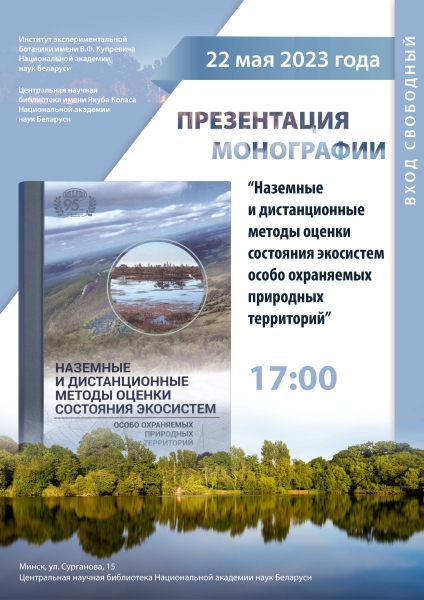

On May 22, 2023 at 05:00 p.m. in the Yakub Kolas Central Scientific Library of the NAS of Belarus (Surganava str., 15, first floor), the staff of the Institute of Experimental Botany named after V.F. Kuprevich of the NAS of Belarus together with the Yakub Kolas Central Scientific Library of the NAS of Belarus will present the monograph "Ground and Remote Methods for Assessing the State of Ecosystems of Specially Protected Natural Areas", which was published in the Belaruskaya Navuka Publishing House. The presentation of the book is timed to the Native Nature Week and the 30th anniversary of the National Environmental Monitoring System in the Republic of Belarus.
The monograph was prepared by a team of authors representing various organizations (Institute of Experimental Botany named after V.F. Kuprevich of the NAS of Belarus; Scientific and Practical Center of the NAS of Belarus on Bioresources; Unitary Enterprise Geoinformation Systems).
The book "Ground and Remote Methods for Assessing the State of Ecosystems of Specially Protected Natural Areas" provides a concept, presents ground and remote methods for assessing the state of ecosystems and threats to biological diversity during integrated monitoring of natural ecological systems in specially protected natural areas (SPNA) as part of the National Environmental Monitoring System in the Republic of Belarus. When conducting this type of monitoring, control is provided for a few simple and inexpensive to define parameters used to assess regional trends in the development of ecosystems of the SPNA, as well as the features of the spatial manifestation of these processes. The practical purpose of the work is to regularly collect data on the state of natural (forest, meadow, swamp and aquatic) ecosystems, on the degree and intensity of their damage by natural and anthropogenic factors, as well as on the dynamics of identified threats to the functioning of ecosystems and biodiversity of SPNA based on remote sensing data.
The book is intended for government officials, specialists in the field of environmental protection and the use of natural resources, researchers and university teachers working in the field of biology and ecology, readers interested in environmental issues.